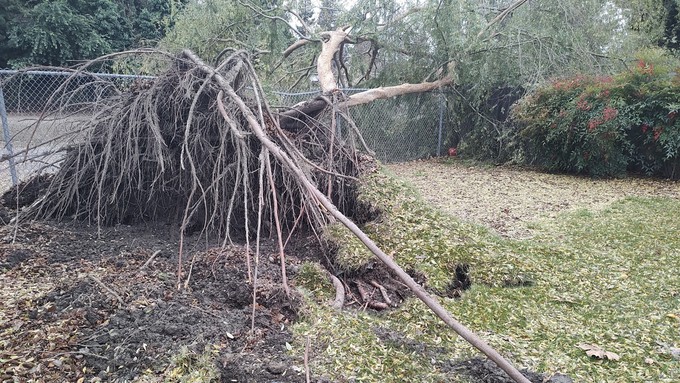
Sacramento's urban forest took a big hit from storms

This elm in the Pocket was one of the early victims of the current series of storms. Debbie Arrington
Besides dumping an amazing amount of rain, these ferocious winter storms have packed a wallop to Sacramento’s famous urban forest. By reported estimates, the City of Trees lost nearly 1,000 trees since New Year’s Eve – and that’s not counting what came down in the wee hours of Tuesday morning.
The City of Sacramento reports that it received about 700 requests for downed tree removal in the first six days of January. Many more requests have come in since.
Removal is a slow process. In that first week, city crews were able to deal with about 200 of the downed trees. Part of the problem? Not enough cranes. Fallen giants weigh tons.
One particularly large victim: The giant sequoia at Capitol Park. About a century old, the mammoth redwood went over and took most of a neighboring Torrey pine with it.
Some Sacramento County and city parks lost dozens of trees. In Yolo County, the UC Davis Arboretum lost at least 15 otherwise healthy trees including a Guadalupe Island cypress planted in 1936.
A combination of saturated soil and extreme wind gusts – some over 60 mph – brought down these big trees, many of which had roots weakened by years of drought.
Through Jan. 9, downtown Sacramento has received 4.48 inches of rain this month. That was on top of 9.52 inches in December including a record 2.37 on New Year’s Eve. That’s nearly 7 inches in 10 days – almost as much rain as Sacramento received in all of 2020. Before December’s deluge, Sacramento’s rain total for the first 11 months of 2022 was 4.31 inches.
So much rain has saturated our slow-draining clay soils. Trees are literally standing in slippery mud, and they’re losing their grips on their soggy toeholds. At some point, those roots start to give way. Called soil separation, this process can form cracks on the surface – like little earthquake faults running through the lawn. It’s one of the few warning signs before a tree goes down.
Cypress, elms and redwoods are among the most common victims of these January storms but so are many other species, especially those with leaves or needles. Foliage on evergreen trees can create a giant sail to catch wind gusts, strong enough to push it over or rip off branches.
Drought’s long-term effects can be seen in the roots of fallen trees. Healthy tree roots grow deep and stretch out as far as the tree’s canopy – the outer reach of its limbs. But often, these toppled giants reveal rootballs that are barely wider than their trunks. Such was the case in Midtown, where fallen 60-foot trees had rootballs no wider than their space between the street and sidewalk. Roots had died back so much, they were no longer strong enough to hold the tree upright.
The solution: Keep trees as healthy as possible before storms hit. That includes deep, infrequent irrigation to encourage strong roots.
In the meantime, watch out for those soil cracks around trunks and be ready for more falling branches. According to the National Weather Service, more rain and wind is in the Sacramento forecast at least through Monday.
For more on tree care and how to hire an arborist: www.sactree.org.
Comments
0 comments have been posted.Sacramento Digs Gardening to your inbox.
Sites We Like
Garden Checklist for week of April 14
It's still not warm enough to transplant tomatoes directly in the ground, but we’re getting there.
* April is the last chance to plant citrus trees such as dwarf orange, lemon and kumquat. These trees also look good in landscaping and provide fresh fruit in winter.
* Smell orange blossoms? Feed citrus trees with a low dose of balanced fertilizer (such as 10-10-10) during bloom to help set fruit. Keep an eye out for ants.
* Apply slow-release fertilizer to the lawn.
* Thoroughly clean debris from the bottom of outdoor ponds or fountains.
* Spring brings a flush of rapid growth, and that means your garden needs nutrients. Fertilize shrubs and trees with a slow-release fertilizer. Or mulch with a 1-inch layer of compost.
* Azaleas and camellias looking a little yellow? If leaves are turning yellow between the veins, give them a boost with chelated iron.
* Trim dead flowers but not leaves from spring-flowering bulbs such as daffodils and tulips. Those leaves gather energy to create next year's flowers. Also, give the bulbs a fertilizer boost after bloom.
* Pinch chrysanthemums back to 12 inches for fall flowers. Cut old stems to the ground.
* Mulch around plants to conserve moisture and control weeds.
* From seed, plant beans, beets, cantaloupes, carrots, corn, cucumbers, melons, radishes and squash.
* Plant onion sets.
* In the flower garden, plant seeds for asters, cosmos, celosia, marigolds, salvia, sunflowers and zinnias.
* Transplant petunias, zinnias, geraniums and other summer bloomers.
* Plant perennials and dahlia tubers for summer bloom.
* Mid to late April is about the last chance to plant summer bulbs, such as gladiolus and tuberous begonias.
* Transplant lettuce seedlings. Choose varieties that mature quickly such as loose leaf.